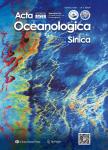A comparison of summer precipitation structures over the South China Sea and the East China Sea based on tropical rainfall measurement mission
A comparison of summer precipitation structures over the South China Sea and the East China Sea based on tropical rainfall measurement mission作者机构:School of Environmental Sciences and EngineeringSun Yat-sen University Zhejiang Sub-bureau of East China Regional Air Traffic Management Bureau of CAAC
出 版 物:《Acta Oceanologica Sinica》 (海洋学报(英文版))
年 卷 期:2013年第32卷第11期
页 面:41-49页
核心收录:
学科分类:0710[理学-生物学] 0908[农学-水产] 07[理学] 0707[理学-海洋科学] 070601[理学-气象学] 0706[理学-大气科学] 071002[理学-动物学]
基 金:The National Key Basic Research Program of China under contract No.2014CB953903 the National Basic Research Programof China under contract No.2011CB403500 the National Natural Science Foundation of China under contract Nos 40775066 and 41275145 the Fundamental Research Funds for the Central Universities under contract No.13lgjc03
主 题:precipitation three-dimensional structures tropical rainfall measurement mission SouthChina Sea East China Sea
摘 要:The three-dimensional structures of summer precipitation over the South China Sea (SCS) and the East China Sea (ECS) are investigated based on tropical rainfall measurement mission (TRMM). The primary results are as follows. First, both the convective and stratiform precipitation rates in the SCS are much higher than those of the ECS. The contribution of the convective cloud precipitation to the surface precipitation is primarily over the SCS and the ECS with a proportion of about 70%, but the contribution of convective cloud precipitation is slightly larger in the SCS than the ECS. The contribution of stratus precipitation is slightly larger in the ECS than that in the SCS. Second, the content of cloud particles and precipitation particles in the ECS in June was greater than that in the SCS, while in July and August, the content of cloud and precipitation particles in the ECS was less than that in the SCS. Third, the latent heat profile of the ECS is quite different from that of the SCS. In June, the peak values of evaporation and condensation latent heating rates in the ECS are greater than those in the SCS. In July and August, however, the peak values of evaporation and condensation latent heating rates in the ECS are about 0.05°/h less than those in the SCS.



